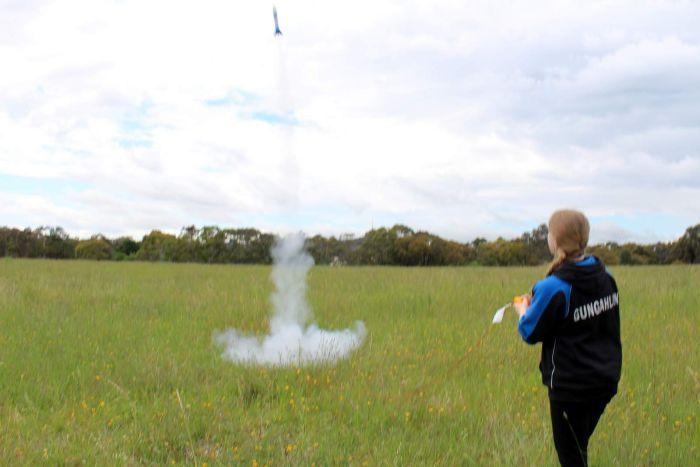“It’s not rocket science.” How many times have you heard that phrase uttered? It’s generally said disparagingly, to slight someone who is failing to grasp something simple. At Australia’s Gungahlin College, a lot of the coursework is, in fact, rocket science.
The school, which prides itself on training its students in the most up-to-date technology, offers a course in mechatronics, a relatively new discipline that is essentially an engineering catch-all, combining mechanical, electrical, computer and software engineering. Gunghalin is one of the few schools in Australia to be equipped with a mechatronics lab, which includes a 3D printer, a laser cutter and CNC router. Recently, the students in year 11 of the discipline, along with year 12 students from the information technology course, took full advantage of the lab’s technology to attempt that most ambitious of scientific endeavors: building and launching a rocket.
The rocket is actually a prototype, just one step in the students’ larger goal, which is to launch a high-altitude air balloon next year. A private sponsorship is enabling the project, and the students hope to send the balloon up to a height of about 35,000 meters from a launch site in New South Wales next April.
“It’s an achievable project with a range of challenges,” said mechatronics teacher Conan O’Brien.
 Some of those challenges have already been tackled in the prototyping stage. The students have built and tested a number of prototypes, the latest being a small cardboard and plastic rocket, constructed partially from 3D printed parts. Student Davide Figuendio designed the rocket’s nose cone and engine block using 3D printing, and was pleased with how efficient the process was.
Some of those challenges have already been tackled in the prototyping stage. The students have built and tested a number of prototypes, the latest being a small cardboard and plastic rocket, constructed partially from 3D printed parts. Student Davide Figuendio designed the rocket’s nose cone and engine block using 3D printing, and was pleased with how efficient the process was.
“It takes about an hour to design the pieces and two hours to print them,” he said. “So if anything goes wrong we can always print a new piece on demand, if it’s necessary.”
Challenges were presented with the rocket’s complex systems of electronics, which included temperature and humidity sensors, an accelerometer, magnetometer, altimeter and a GPS. Because the components were all from different manufacturers, they were a bit difficult to integrate into a working circuit board. To circumvent the issue in the future, the students are currently working on designing a custom circuit board, one that will integrate all needed components.
Issues aside, the students successfully launched the rocket last week. The prototype was fired to a height of about 130 meters, with a satisfyingly straight flight path. A parachute brought the rocket down about 40 meters from where it was launched. Despite the challenges the students had encountered, it appeared that their design was successful. Unfortunately, one more issue arose: the memory card never captured the data it had been designed to record, a problem that the students are working on solving before another test launch next week.
The launch button was pushed by the only female student in the mechatronics class. Madeleine Mackey believes that not enough women are pursuing careers in the sciences, and she hopes to encourage other female students to study science despite lingering stereotypes.
“It’s not really the gender that really matters in this class, it’s … the enthusiasm and passion for rocket science,” Mackey said. “I think there’s just this stereotype you know that girls aren’t really good at IT and sciences and that kind of thing.”
Such stereotypes are, of course, nonsense, and hopefully more female students will follow Mackey’s lead in pursuing degrees in science and engineering. With technology expanding so quickly, there will be a lot of space to fill in the science and technology fields, and women and men should be equally encouraged to fill that space. It’s not rocket science, after all.
[Source/Images: ABC Canberra]Subscribe to Our Email Newsletter
Stay up-to-date on all the latest news from the 3D printing industry and receive information and offers from third party vendors.
Print Services
Upload your 3D Models and get them printed quickly and efficiently.
You May Also Like
Consolidation in AM: How 2025 Is Shaping the Industry’s New Normal
The first half of 2025 has been marked by a clear shift in the additive manufacturing (AM) industry. Companies are no longer just focused on developing new tech by themselves....
Etsy Design Rule Change Reduces Selection of 3D Printed Goods
Online marketplace Etsy has implemented a rule change requiring all 3D printed goods on the site to be original designs. The update to the site’s Creativity Standards states, ¨Items produced using...
U.S. Congress Calls Out 3D Printing in Proposal for Commercial Reserve Manufacturing Network
Last week, the U.S. House of Representatives’ Appropriations Committee moved the FY 2026 defense bill forward to the House floor. Included in the legislation is a $131 million proposal for...
Transforming From Tourist to Native: Duro CEO Michael Corr Explains Why the Company Rebuilt its PLM Software on AI
In these early innings of the AI boom, many market analysts have expressed concern that AI spend has gotten too far ahead of the technology’s proven ability to deliver significant...



































